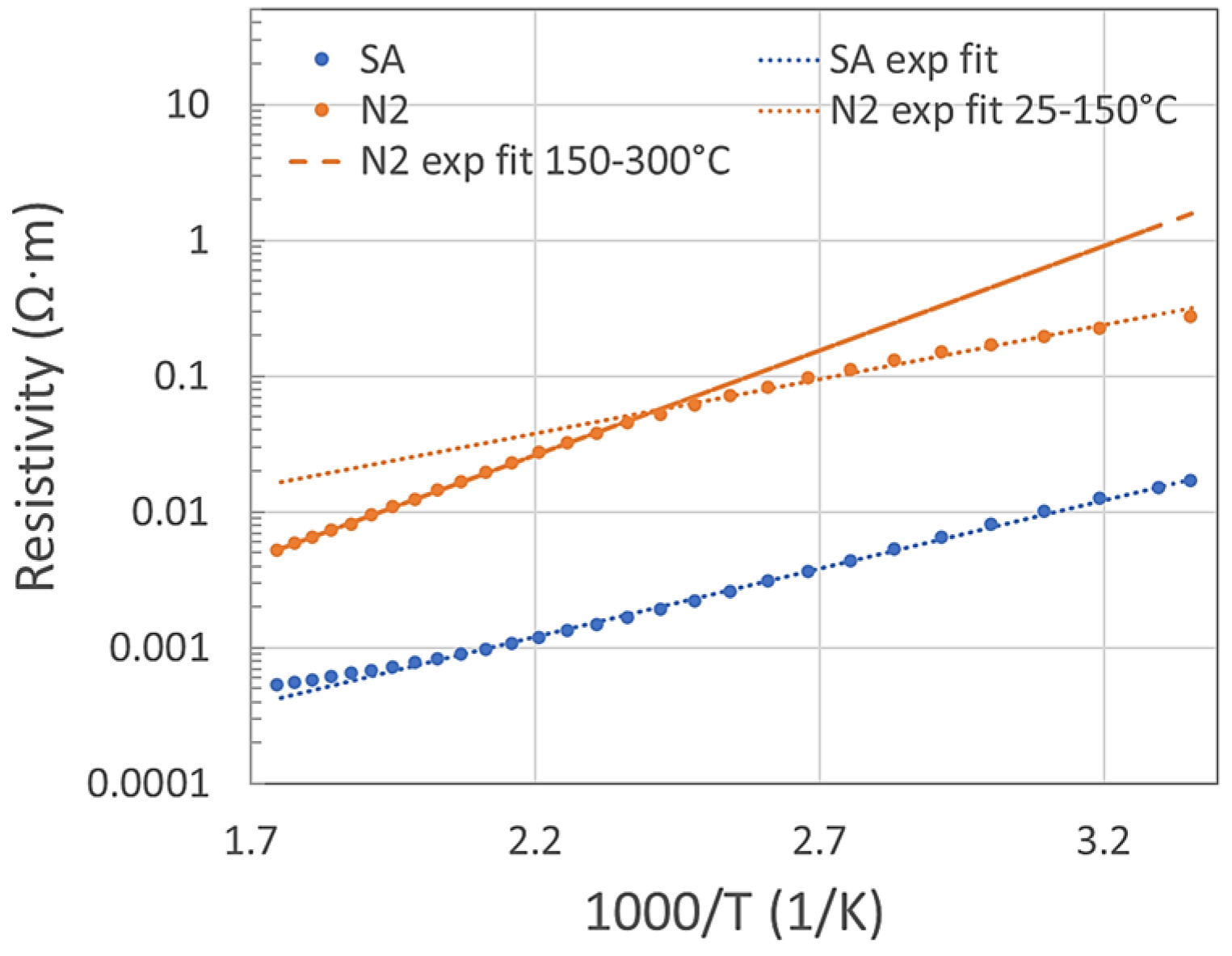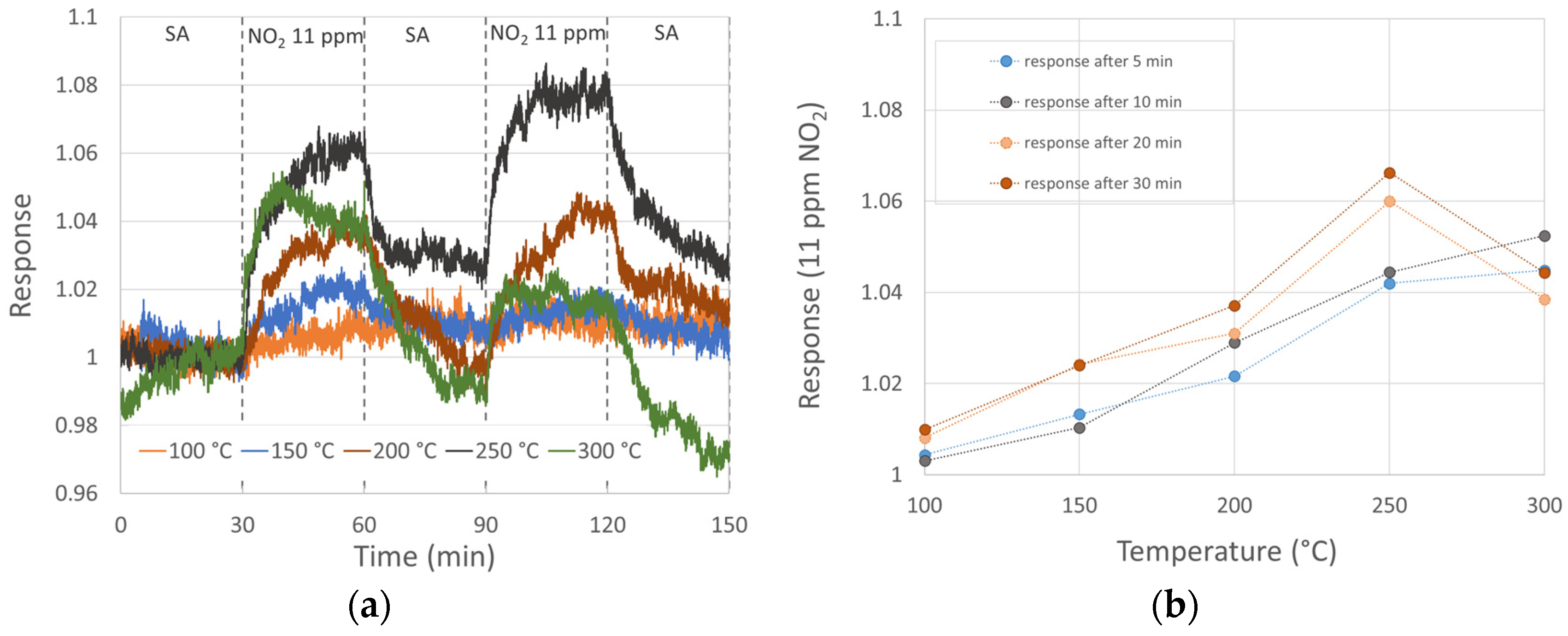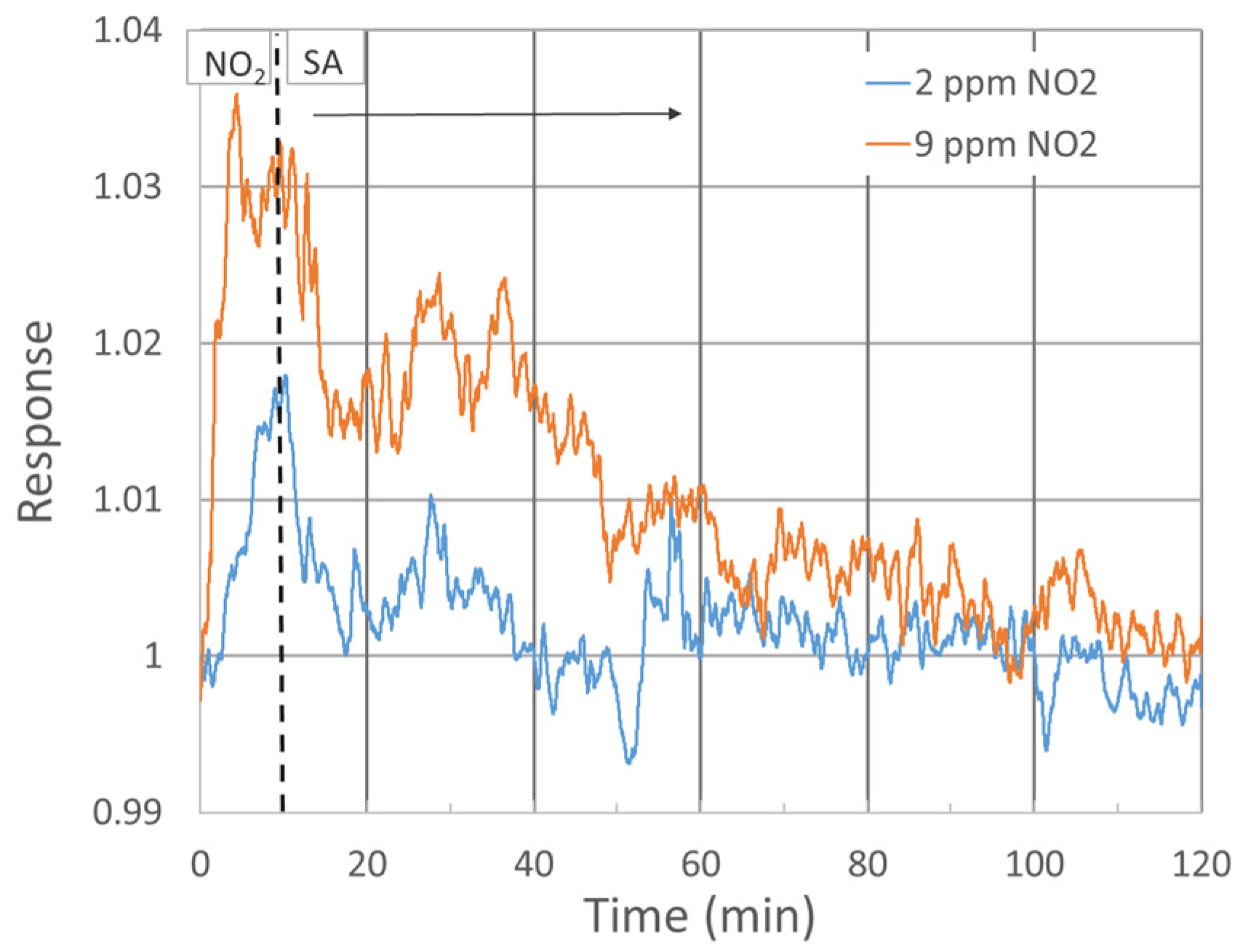Electrical Characterization of Hydrothermally Synthesized Manganese Dioxide Nanowires with Regard to NO2 Adsorption/Desorption Thermodynamics †
Abstract
:1. Introduction
2. Materials and Methods
2.1. Sample Preparation and Stabilization
2.2. Thermal Resistivity Analysis
2.3. NO2 Thermal Analysis
2.4. NO2 Concentration Analysis
3. Results and Discussion
3.1. Thermal Resistivity Analysis
3.2. NO2 Thermal Analysis
3.3. NO2 Concentration Analysis
4. Conclusions
Author Contributions
Funding
Institutional Review Board Statement
Informed Consent Statement
Data Availability Statement
Conflicts of Interest
References
- Umar, A.; Ibrahim, A.A.; Kumar, R.; Albargi, H.; Zeng, W.; Alhmami, M.A.M.; Alsaiari, M.A.; Baskoutas, S. Gas sensor device for high-performance ethanol sensing using α-MnO2 nanoparticles. Mater. Lett. 2021, 286, 129232. [Google Scholar] [CrossRef]
- Barreca, D.; Gasparotto, A.; Gri, F.; Comini, E.; Maccato, C. Plasma-assisted growth of β-MnO2 Nanosystems as Gas Sensors for Safety and Food Industry Applications. Adv. Mater. Interfaces 2018, 5, 1800792. [Google Scholar] [CrossRef]
- Pedowitz, M.D.; Kim, S.; Lewis, D.I.; Uppalapati, B.; Khan, D.; Bayram, F.; Daniels, K.M. Fast selective sensing of nitrogen-based gases utilizing δ-MnO2-epitaxial graphene-silicon carbide heterostructures for room temperature gas sensing. J. Microelectromech. Syst. 2020, 29, 846–852. [Google Scholar] [CrossRef]
- Wang, X.; Li, Y. Selected-control hydrothermal synthesis of α- and β-MnO2 single crystal nanowires. J. Am. Chem. Soc. 2002, 124, 2880–2881. [Google Scholar] [CrossRef] [PubMed]
- Liu, C.; Navale, S.T.; Yang, Z.B.; Galluzzi, M.; Patil, V.B.; Cao, P.J.; Mane, R.S.; Stadler, F.J. Ethanol gas sensing properties of hydrothermally grown a-MnO2 nanorods. J. Alloys Compd. 2017, 727, 362–369. [Google Scholar] [CrossRef]
- Zhang, W.; Zeng, C.; Kong, M.; Pan, Y.; Yang, Z. Water-evaporation-induced self-assembly of a-MnO2 hierarchical hollow nanospheres and their applications in ammonia gas sensing. Sens. Actuators B Chem. 2012, 162, 292–299. [Google Scholar] [CrossRef]
- Sovizi, M.R.; Mirzakhani, S. Highly sensitive detection of ammonia gas by 3D flower-like γ-MnO2 nanostructure chemiresistor. J. Taiwan Inst. Chem. Eng. 2020, 111, 293–301. [Google Scholar] [CrossRef]
- Xiao, J.; Liu, P.; Liang, Y.; Li, H.B.; Yang, G.W. High aspect ratio β-MnO2 nanowires and sensor performance for explosive gases. J. Appl. Phys. 2013, 114, 073513. [Google Scholar] [CrossRef]
- Bigiani, L.; Zappa, D.; Maccato, C.; Comini, E.; Barreca, D.; Gasparotto, A. Quasi-1D MnO2 nanocomposites as gas sensors for hazardous chemicals. Appl. Surf. Sci. 2020, 512, 145667. [Google Scholar] [CrossRef]
- Shinde, P.V.; Xia, Q.X.; Ghule, B.G.; Shinde, N.M.; Seonghee, J.; Kim, K.H.; Mane, R.S. Hydrothermally grown α-MnO2 interlocked mesoporous micro-cubes of several nanocrystals as selective and sensitive nitrogen dioxide chemoresistive gas sensors. Appl. Surf. Sci. 2018, 442, 178–184. [Google Scholar] [CrossRef]
- Claros, M.; Kuta, J.; El-Dahshan, O.; Michalička, J.; Jimenez, Y.P.; Vallejos, S. Hydrothermally synthesized MnO2 nanowires and their application in Lead (II) and Copper (II) batch adsorption. J. Mol. Liq. 2021, 325, 115203. [Google Scholar] [CrossRef]
- Smisitel, P.; Simunkova, H.; Chmela, O.; Claros, M.; Vallejos, S.; Hubalek, J. Electrical characterization of hydrothermally synthesized metal oxide nanowires with regard to oxygen adsorption/desorption thermodynamics. In Proceedings of the 14th International Conference on Nanomaterials, NANOCON 2022, Brno, Czech Republic, 19–21 October 2022; pp. 64–70. [Google Scholar] [CrossRef]
- Kim, H.-J.; Lee, J.-H. Highly sensitive and selective gas sensors using p-type oxide semiconductors: Overview. Sens. and Actuators B Chem. 2014, 192, 607–627. [Google Scholar] [CrossRef]
- Julien, C.M.; Massot, M.; Poinsignon, C. Lattice vibrations of manganese oxides: Part I. Periodic structures. Spectrochim. Acta Part A Mol. Biomol. Spectrosc. 2004, 60, 689–700. [Google Scholar] [CrossRef]
- Bailey, M.R.; Donne, S.W. Electrochemical impedance spectroscopy study into the effect of titanium dioxide added to the alkaline manganese dioxide cathode. J. Electrochem. Soc. 2011, 158, A802. [Google Scholar] [CrossRef]
- Ruetschi, P. Cation-vacancy model for MnO2. J. Electrochem. Soc. 1984, 131, 2737. [Google Scholar] [CrossRef]
- Ruetschi, P. Influence of cation vacancies on the electrode potential of MnO2. J. Electrochem. Soc. 1988, 135, 2657. [Google Scholar] [CrossRef]
- Ruetschi, P.; Giovanoli, R. Cation vacancies in MnO2 and their influence on electrochemical reactivity. J. Electrochem. Soc. 1988, 135, 2663. [Google Scholar] [CrossRef]
- Chabre, Y.; Pannetier, J. Structural and electrochemical properties of the proton/γ-MnO2 system. Prog. Solid State Chem. 1995, 23, 2737. [Google Scholar] [CrossRef]
- Heuer, A.H.; He, A.Q.; Hughes, P.J.; Feddrix, F.H. Batteries New Technol. ITE Lett. Med. 2000, 1, 926. [Google Scholar]
- Donne, S.W.; Lawrance, G.A.; Swinkels, D.A.J. Redox processes at the manganese dioxide electrode: I. constant-current intermittent discharge. J. Electrochem. Soc. 1997, 144, 2949. [Google Scholar] [CrossRef]
- Iwamoto, M.; Yoda, Y.; Yamazoe, N.; Seiyama, T. Study of metal oxide catalysts by temperature programmed desorption. 4. Oxygen adsorption on various metal oxides. J. Phys. Chem. 1978, 82, 2564–2570. [Google Scholar] [CrossRef]




Disclaimer/Publisher’s Note: The statements, opinions and data contained in all publications are solely those of the individual author(s) and contributor(s) and not of MDPI and/or the editor(s). MDPI and/or the editor(s) disclaim responsibility for any injury to people or property resulting from any ideas, methods, instructions or products referred to in the content. |
© 2023 by the authors. Licensee MDPI, Basel, Switzerland. This article is an open access article distributed under the terms and conditions of the Creative Commons Attribution (CC BY) license (https://creativecommons.org/licenses/by/4.0/).
Share and Cite
Smisitel, P.; Simunkova, H.; Chmela, O.; Claros, M.; Vallejos, S.; Hubalek, J. Electrical Characterization of Hydrothermally Synthesized Manganese Dioxide Nanowires with Regard to NO2 Adsorption/Desorption Thermodynamics. Eng. Proc. 2023, 48, 35. https://doi.org/10.3390/CSAC2023-14883
Smisitel P, Simunkova H, Chmela O, Claros M, Vallejos S, Hubalek J. Electrical Characterization of Hydrothermally Synthesized Manganese Dioxide Nanowires with Regard to NO2 Adsorption/Desorption Thermodynamics. Engineering Proceedings. 2023; 48(1):35. https://doi.org/10.3390/CSAC2023-14883
Chicago/Turabian StyleSmisitel, Petr, Helena Simunkova, Ondrej Chmela, Martha Claros, Stella Vallejos, and Jaromir Hubalek. 2023. "Electrical Characterization of Hydrothermally Synthesized Manganese Dioxide Nanowires with Regard to NO2 Adsorption/Desorption Thermodynamics" Engineering Proceedings 48, no. 1: 35. https://doi.org/10.3390/CSAC2023-14883
APA StyleSmisitel, P., Simunkova, H., Chmela, O., Claros, M., Vallejos, S., & Hubalek, J. (2023). Electrical Characterization of Hydrothermally Synthesized Manganese Dioxide Nanowires with Regard to NO2 Adsorption/Desorption Thermodynamics. Engineering Proceedings, 48(1), 35. https://doi.org/10.3390/CSAC2023-14883






